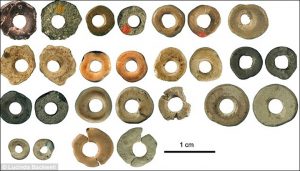Archaeologists continuing the excavations at the Denisova Cave in the Altai region of Russian Federation, discovered Palaeolithic jewellery made out of ostrich eggshells between 45000-50000 years ago.

A collection of beads made of cut and drilled ostrich eggshells has recently been gathered by archaeologists working in the Denisova Cave in Altai. According to the archaeologists the beads are between 50000 and 45000 years old, being created in the Upper Palaeolithic Era. But what’s more striking is that they have been found 11500 kilometres away from South Africa where similar, younger ones are known to have been found.

According to the experts, the beads are an amazing piece of work as the ostrich egg shell is a quite hard and large material and the holes must have been made with a fine stone drill. The finds are considered to be an exquisite jewellery work of a very talented artist. On of the beads measures one centimetre in diameter, with a hole inside that is slightly wider than a millimetre. It is believed that the the beads may have been sewn into clothing – or formed part of a bracelet or necklace.

The archaeologists admit that they do not know where the beads were made. It is possible that they have been exported from Trans-Baikal or Mongolia with the beads manufactured here or were purchased elsewhere and delivered to the Altai Mountains by means of exchange. It proves however that the people from the Denisova Cave were either advanced in technologies or had very well-established contacts with the outside world.

The beads were found in the same layer than the previously discovered world’s oldest bracelet made from rare dark green stone – all dated to the same period around 45000 years ago. The archaeologists found three beads during excavations throughout 2005-2008, and these finds were lying scattered within 6 metres in the eastern gallery of the cave. They are said to look identically as the ones found recently. They are also similar to the ostrich eggshell beads found in Border Cave in South Africa that have been dated up to 44000 years old. This new finds raises more questions than in provides answers about the unique site which for at least 288000 years was occupied by Homo sapiens along with now extinct early humans – Neanderthals and Denisovans.

The Denisovans is an extinct species of human in the genus Homo, deriving its name from the discovery of a finger bone fragment of a juvenile female who lived about 41,000 years ago, found in the remote Denisova Cave. Analysis of the mitochondrial DNA of the finger bone showed that it was genetically distinct from the mtDNAs of Neanderthals and modern humans and that Denisovans shared a common origin with Neanderthals.
(after The Siberian Times)